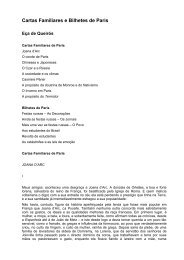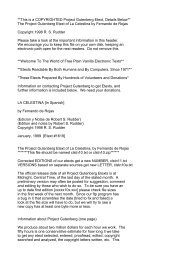The Interpretation of Dreams Sigmund Freud (1900)
The Interpretation of Dreams Sigmund Freud (1900)
The Interpretation of Dreams Sigmund Freud (1900)
Create successful ePaper yourself
Turn your PDF publications into a flip-book with our unique Google optimized e-Paper software.
expressing in the picture.<br />
Here, perhaps an objection will be raised, challenging the assertion that our dreams dispense with the representation <strong>of</strong> logical relations. <strong>The</strong>re are<br />
dreams in which the most complicated intellectual operations take place; arguments for and against are adduced, jokes and comparisons are made,<br />
just as in our waking thoughts. But here again appearances are deceptive; if the interpretation <strong>of</strong> such dreams is continued it will be found that all<br />
these things are dream-material, not the representation <strong>of</strong> intellectual activity in the dream. <strong>The</strong> content <strong>of</strong> the dream-thoughts is reproduced by<br />
the apparent thinking in our dreams, but not the relations <strong>of</strong> the dream-thoughts to one another, in the determination <strong>of</strong> which relations thinking<br />
consists. I shall give some examples <strong>of</strong> this. But the fact which is most easily established is that all speeches which occur in dreams, and which<br />
are expressly designated as such, are unchanged or only slightly modified replicas <strong>of</strong> speeches which occur likewise among the memories in the<br />
dream-material. Often the speech is only an allusion to an event contained in the dream-thoughts; the meaning <strong>of</strong> the dream is quite different.<br />
However, I shall not dispute the fact that even critical thought - activity, which does not simply repeat material from the dream - thoughts, plays a<br />
part in dream-formation. I shall have to explain the influence <strong>of</strong> this factor at the close <strong>of</strong> this discussion. It will then become clear that this<br />
thought activity is evoked not by the dream-thoughts, but by the dream itself, after it is, in a certain sense, already completed.<br />
Provisionally, then, it is agreed that the logical relations between the dream-thoughts do not obtain any particular representation in the dream. For<br />
instance, where there is a contradiction in the dream, this is either a contradiction directed against the dream itself or a contradiction contained in<br />
one <strong>of</strong> the dream-thoughts; a contradiction in the dream corresponds with a contradiction between the dream-thoughts only in the most indirect<br />
and intermediate fashion.<br />
But just as the art <strong>of</strong> painting finally succeeded in depicting, in the persons represented, at least the intentions behind their words - tenderness,<br />
menace, admonition, and the like - by other means than by floating labels, so also the dream has found it possible to render an account <strong>of</strong> certain<br />
<strong>of</strong> the logical relations between its dream-thoughts by an appropriate modification <strong>of</strong> the peculiar method <strong>of</strong> dream-representation. It will be<br />
found by experience that different dreams go to different lengths in this respect; while one dream will entirely disregard the logical structure <strong>of</strong> its<br />
material, another attempts to indicate it as completely as possible. In so doing, the dream departs more or less widely from the text which it has to<br />
elaborate; and its attitude is equally variable in respect to the temporal articulation <strong>of</strong> the dream-thoughts, if such has been established in the<br />
unconscious (as, for example, in the dream <strong>of</strong> Irma's injection).<br />
But what are the means by which the dream-work is enabled to indicate those relations in the dream-material which are difficult to represent? I<br />
shall attempt to enumerate these, one by one.<br />
In the first place, the dream renders an account <strong>of</strong> the connection which is undeniably present between all the portions <strong>of</strong> the dream-thoughts by<br />
combining this material into a unity as a situation or a proceeding. It reproduces logical connections in the form <strong>of</strong> simultaneity; in this case it<br />
behaves rather like the painter who groups together all the philosophers or poets in a picture <strong>of</strong> the School <strong>of</strong> Athens, or Parnassus. <strong>The</strong>y never<br />
were assembled in any hall or on any mountain-top, although to the reflective mind they do constitute a community.<br />
<strong>The</strong> dream carries out in detail this mode <strong>of</strong> representation. Whenever it shows two elements close together, it vouches for a particularly intimate<br />
connection between their corresponding representatives in the dream-thoughts. It is as in our method <strong>of</strong> writing: to signifies that the two letters<br />
are to be pronounced as one syllable; while t with o following a blank space indicates that t is the last letter <strong>of</strong> one word and o the first letter <strong>of</strong><br />
another. Consequently, dream-combinations are not made up <strong>of</strong> arbitrary, completely incongruous elements <strong>of</strong> the dream-material, but <strong>of</strong><br />
elements that are pretty intimately related in the dream-thoughts also.<br />
For representing causal relations our dreams employ two methods, which are essentially reducible to one. <strong>The</strong> method <strong>of</strong> representation more<br />
frequently employed - in cases, for example, where the dream-thoughts are to the effect: "Because this was thus and thus, this and that must<br />
happen" - consists in making the subordinate clause a prefatory dream and joining the principal clause on to it in the form <strong>of</strong> the main dream. If<br />
my interpretation is correct, the sequence may likewise be reversed. <strong>The</strong> principal clause always corresponds to that part <strong>of</strong> the dream which is<br />
elaborated in the greatest detail.<br />
An excellent example <strong>of</strong> such a representation <strong>of</strong> causality was once provided by a female patient, whose dream I shall subsequently give in full.<br />
<strong>The</strong> dream consisted <strong>of</strong> a short prologue, and <strong>of</strong> a very circumstantial and very definitely centred dream-composition. I might entitle it "Flowery<br />
language." <strong>The</strong> preliminary dream is as follows: She goes to the two maids in the kitchen and scolds them for taking so long to prepare "a little<br />
bite <strong>of</strong> food." She also sees a very large number <strong>of</strong> heavy kitchen utensils in the kitchen turned upside down in order to drain, even heaped up in<br />
stacks. <strong>The</strong> two maids go to fetch water, and have, as it were, to climb into a river, which reaches up to the house or into the courtyard.<br />
<strong>The</strong>n follows the main dream, which begins as follows: She is climbing down from a height over a curiously shaped trellis, and she is glad that<br />
her dress doesn't get caught anywhere, etc. Now the preliminary dream refers to the house <strong>of</strong> the lady's parents. <strong>The</strong> words which are spoken in<br />
the kitchen are words which she has probably <strong>of</strong>ten heard spoken by her mother. <strong>The</strong> piles <strong>of</strong> clumsy pots and pans are taken from an<br />
unpretentious hardware shop located in the same house. <strong>The</strong> second part <strong>of</strong> this dream contains an allusion to the dreamer's father, who was<br />
always pestering the maids, and who during a flood - for the house stood close to the bank <strong>of</strong> the river - contracted a fatal illness. <strong>The</strong> thought









